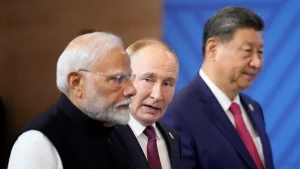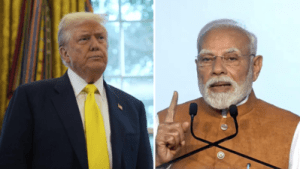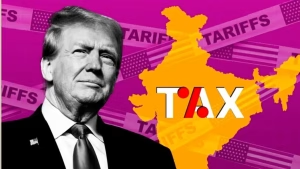Washington D.C. – US President Donald Trump made a startling statement on Thursday regarding the evolving geopolitical landscape, declaring that America has “lost India and Russia to deepest, darkest China.” This Trump India China commentary represents his sharpest public acknowledgment of the shifting global alliances that have emerged following recent diplomatic developments in Asia.
Trump’s remarks came through a social media post on his Truth Social platform, where he sarcastically wished the three nations a “long and prosperous future together.” The Trump India China statement reflects growing concerns in Washington about the deepening cooperation between these major powers and their collective distancing from American influence.
SCO Summit Triggers Diplomatic Concerns

The catalyst for Trump’s Trump India China remarks was the recent Shanghai Cooperation Organisation summit held in Tianjin, where Chinese President Xi Jinping hosted both Prime Minister Narendra Modi and Russian President Vladimir Putin. This gathering marked a significant diplomatic moment, particularly as it represented Modi’s first visit to China in seven years.
The summit demonstrated the potential for enhanced cooperation between the three nations across multiple sectors, including energy and security arrangements. For Trump, this Trump India China development signaled a concerning shift away from traditional Western alliances and toward what he perceives as a China-centric regional bloc.
The meeting’s significance extends beyond mere diplomatic protocol, as it occurred against the backdrop of long-standing India-China tensions, including the deadly 2020 border clash in the Galwan Valley. Modi’s willingness to engage with Xi Jinping suggests a strategic recalibration that has clearly troubled the Trump administration.
Historical Context of US-India Relations


The Trump India China dynamic represents a dramatic shift from previous decades when Washington viewed India as a crucial counterweight to China’s expanding regional influence. Both Republican and Democratic administrations have invested substantially in cultivating New Delhi as a strategic partner in containing Chinese power.
During his first presidential term, Trump actively courted India, participating in the memorable 2019 “Howdy Modi” rally in Houston and reviving the Quadrilateral Security Dialogue (Quad) with Japan and Australia. These initiatives were specifically designed to strengthen the Trump India China strategic equation in America’s favor.
Also Read: Trump WW2 Comment: Explosive Criticism of China’s War Anniversary Ceremony
However, recent developments suggest that this carefully constructed partnership is experiencing significant strain. The Trump India China relationship has become increasingly complicated by competing economic interests and divergent approaches to global challenges, particularly regarding Russia and energy security.
Economic Tensions and Trade Disputes

The deteriorating Trump India China relationship has manifested most clearly through aggressive trade policies. Since returning to office, Trump has imposed combined tariffs of 50 percent on Indian goods, including 25 percent reciprocal tariffs plus an additional 25 percent levy specifically targeting India’s Russian oil imports.
These represent some of the steepest tariffs Washington has placed on any trade partner, reflecting Trump’s frustration with what he perceives as an unfair trading relationship. Trump has repeatedly argued that the Trump India China economic dynamics favor both countries at America’s expense, stating that “we do very little business with India, but they do a tremendous amount of business with us.”
The president characterized the trade relationship as “a totally one-sided disaster,” emphasizing that India purchases most of its oil and military products from Russia rather than the United States. This economic dimension of the Trump India China equation has become a significant source of bilateral tension.
Energy Trade as a Flashpoint
Energy commerce has emerged as a particularly contentious issue in the Trump India China discussion. Trump has accused India of effectively financing Moscow’s war in Ukraine through its purchases of discounted Russian crude oil, viewing this as indirect support for Russian military operations.
External Affairs Minister S. Jaishankar has countered these accusations by pointing out that the United States has not applied similar standards to China or the European Union, both of which remain major importers of Russian energy. This defense highlights the complex Trump India China triangular relationship where energy security considerations often override political alignments.
Strategic Autonomy vs. Alliance Obligations
Modi’s participation in the SCO summit signals India’s commitment to strategic autonomy rather than exclusive alignment with any single power bloc. This approach directly challenges the Trump India China framework that Washington has been trying to establish, where India would serve as a reliable counterweight to Chinese influence.
By meeting with both Xi Jinping and Vladimir Putin, Modi demonstrated India’s willingness to engage with all major powers based on national interests rather than ideological considerations. This pragmatic approach to the Trump India China relationship represents a significant shift in global diplomatic dynamics.
The current trajectory suggests that traditional alliance structures may be giving way to more fluid, interest-based partnerships that prioritize economic cooperation and regional stability over Cold War-era bloc politics, fundamentally altering the Trump India China strategic landscape.

